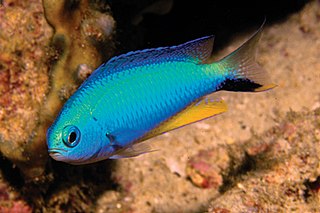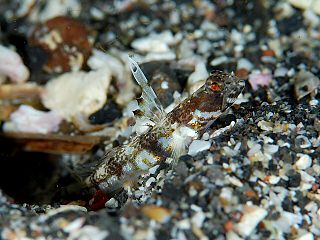
The Allen's gallinule, formerly known as the lesser gallinule is a small waterbird of the family Rallidae. Its former binomial name is Porphyrula alleni. Porphyrio is the Latin for "swamphen", and alleni, like the English name, commemorates British naval officer Rear-Admiral William Allen (1792–1864).

The egg is the organic vessel containing the zygote in which an embryo develops until it can survive on its own; at which point the animal hatches. An egg results from fertilization of an egg cell. Most arthropods, vertebrates, and mollusks lay eggs, although some, such as scorpions do not.

The antelope jackrabbit, found in Southern Arizona and Northwestern Mexico, is a species of North American hare. Within this range, it occupies dry desert areas. This species is placed in family Leporidae, which is within order Lagomorpha. Male and female antelope jackrabbits are identical in appearance. This species is large in size with long, pointed ears and a distinct coat coloration. The antelope jackrabbit has a white belly, light grey sides, a back peppered with black, and orange coloration on the neck and chest. It is similar to species like the black-tailed jackrabbit and white-sided jackrabbit. It is most active during twilight (crepuscular) and during the night (nocturnal), but can be active during the day when conditions are favorable. It feeds on cacti, mesquite leaves, and other vegetation.

The blue crayfish is a species of freshwater crayfish endemic to Florida in the United States. Its natural range is the area east of St. Johns River and all of Florida from Levy County and Marion County southwards, as well as on some of the Florida Keys. It is included on the IUCN Red List as a species of Endangered. The blue crayfish is threatened by deforestation. In the wild, this species varies from brown-tan to blue, but the aquarium strain has been selective bred to achieve a brilliant cobalt blue color.

Allen's yellow bat is a species of vesper bat. There is some taxonomic debate surrounding this species, with some authors considering Baeodon a genus rather than a subgenus. It is endemic to Mexico.

Bioko Allen's bushbaby is a species of primate in the family Galagidae found in Cameroon, Equatorial Guinea and Nigeria. Its natural habitat is subtropical or tropical dry forests. The bushbaby is currently a Least-concern species, according to the International Union for Conservation of Nature.

Spawn is the eggs and sperm released or deposited into water by aquatic animals. As a verb, to spawn refers to the process of releasing the eggs and sperm, and the act of both sexes is called spawning. Most aquatic animals, except for aquatic mammals and reptiles, reproduce through the process of spawning.

Pomacentrus alleni, the Andaman damsel, is a Damselfish from the Eastern Indian Ocean. It occasionally makes its way into the aquarium trade. It grows to a size of 6 cm in length. The specific name honours the ichthyologist Gerald R. Allen of the Western Australia Museum in Perth.
Manonichthys alleni, the Sabah dottyback is a species of ray-finned fish from the family Pseudochromidae, the dottybacks. It occasionally makes its way into the aquarium trade. It grows to a size of 12 centimetres (4.7 in) in length. This dottyback has only been known from Indonesia and Malaysia, but was recently recorded in the Davao Gulf in the southern Philippines. The specific name honours the ichthyologist Gerald R. Allen of the Western Australian Museum in Perth who collected the type specimen and provided photographs of this species which Gill used in his description, as well as being in recognition of Allen's contribution to the knowledge of Indo-Pacific fish and of the support Allen gave Gill in is work on the Pseudochromidae.
Pavoraja nitida, commonly known as the peacock skate, is a species of fish in the family Arhynchobatidae. It lives near the soft bottoms of the continental shelf near the coast of Australia and New Zealand in depths ranging from 30 to 390 metres. It produces oblong egg capsules which have stiff horns in each corner and lays them in sandy or muddy flats. Its maximum size is 36.8 cm.
Pavoraja mosaica, commonly known as the mosaic skate, is a species of fish in the family Arhynchobatidae. It lives in depths ranging from 300 meters to 450 meters off the northeastern coast of Australia. Its maximum size is 27.9 cm (11.0 in) total length.
Pavoraja pseudonitida, commonly known as the false peacock skate, is a species of fish in the family Arhynchobatidae. It lives in depths ranging from 212 to 512 meters in the western Pacific ocean off the coast of north-eastern Australia. Its maximum size is 37.2 cm (14.6 in) total length.
Pavoraja umbrosa, commonly known as the dusky skate, is a species of fish in the family Arhynchobatidae. It lives off the coast of north-eastern Australia in depths ranging from 360 to 731 meters. Its maximum size is 36.9 cm (14.5 in) total length.

Ecsenius alleni, known commonly as the Allen's blenny, is a species of combtooth blenny in the genus Ecsenius. It is found in coral reefs in the eastern Indian ocean, specifically in western Australia. It can reach a maximum length of 3.4 centimetres. The blennies feed primarily off of plants and algae. The specific name honours the ichthyologist Gerald R. Allen.
The slender blenny is a species of chaenopsid blenny found around Panama, known from one species collected at Isla del Rey. It can reach a length of 5.4 centimetres (2.1 in) TL. The specific name honours the collector of the type, Gerald R. Allen of the Western Australia Museum in Perth.

Ctenobrycon is a genus of fish of the family Characidae found in tropical South America, with five currently recognized species in this genus. Ctenobrycon species can be located is fresh water in tropical climates in South America, commonly in calm waters. Their diet includes zooplankton, plants, worms, insects, and crustaceans.

Ichthyoplankton are the eggs and larvae of fish. They are mostly found in the sunlit zone of the water column, less than 200 metres deep, which is sometimes called the epipelagic or photic zone. Ichthyoplankton are planktonic, meaning they cannot swim effectively under their own power, but must drift with the ocean currents. Fish eggs cannot swim at all, and are unambiguously planktonic. Early stage larvae swim poorly, but later stage larvae swim better and cease to be planktonic as they grow into juveniles. Fish larvae are part of the zooplankton that eat smaller plankton, while fish eggs carry their own food supply. Both eggs and larvae are themselves eaten by larger animals.

Juvenile fish go through various stages between birth and adulthood. They start as eggs which hatch into larvae. The larvae are not able to feed themselves, and carry a yolk-sac which provides their nutrition. Before the yolk-sac completely disappears, the tiny fish must become capable of feeding themselves. When they have developed to the point where they are capable of feeding themselves, the fish are called fry. When, in addition, they have developed scales and working fins, the transition to a juvenile fish is complete and it is called a fingerling. Fingerlings are typically about the size of fingers. The juvenile stage lasts until the fish is fully grown, sexually mature and interacting with other adult fish.

Tomiyamichthys alleni, Allen's shrimpgoby, is a species of ray-finned fish from the family Gobiidae. It occurs in the western Pacific Ocean where its is commensal with an aplheid shrimp.














